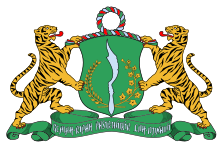Anwar Cabinet
The Anwar Cabinet (Indonesian: Kabinet Anwar) was the fifth cabinet established by the State of Pasundan. It was composed of 11 ministers. Its term of office ran from 11 to 23 January 1950.
| Anwar Cabinet | |
|---|---|
5th Cabinet of Pasundan | |
| Date formed | 11 January 1950 |
| Date dissolved | 23 January 1950 |
| People and organisations | |
| Head of state | Wiranatakusumah |
| Head of government | Anwar Tjokroaminoto |
| No. of ministers | 11 |
| History | |
| Predecessor | Djumhana III |
Background
After the recognition of Indonesia by the Dutch government on 27 December 1949, the previous prime minister Djumhana Wiriaatmadja resigned as the prime minister. Djumhana was replaced by Anwar Tjokroaminoto, the son of the national hero Oemar Said Tjokroaminoto.[1] Initially, after the resignation, the task of forming the new cabinet and the position of the prime minister was given to Sewaka. Sewaka accepted this offer, but he also insisted that the programs of the cabinet would carry out efforts towards the dissolution of the State of Pasundan. Sewaka's demands were firmly rejected by Wiranatakusumah.[2] The task was therefore given to Anwar Tjokroaminoto. Anwar was given the mandate to form the cabinet by Wiranatakusumah on 7 January 1950.[3] He finished forming his cabinet on 9 January 1950,[4] and the cabinet was installed on 11 January 1950.[5]
There were several changes regarding to the nomenclature of the ministries in the Anwar Cabinet. There were two new ministries, the Ministry of Religious Affairs and the Ministry of Enlightenment.[4]
Composition
Ministers
| Portfolio | Minister | Took office | Left office | Ref |
|---|---|---|---|---|
| Prime Minister Minister of Home Affairs | Anwar Tjokroaminoto | 11 January 1950 | 23 January 1950 | [4] |
| Minister of Economy | Suradiradja | 11 January 1950 | 23 January 1950 | [4] |
| Minister of Finance | P. J. Gerke | 11 January 1950 | 23 January 1950 | [4] |
| Minister of Education | Otto Judakusuma | 11 January 1950 | 23 January 1950 | [4] |
| Minister of Transportation and Irrigation | Soeriakartalegawa | 11 January 1950 | 23 January 1950 | [4] |
| Minister of Social Affairs | Sjafei Wirakusumah | 11 January 1950 | 23 January 1950 | [4] |
| Minister of Justice Minister of Enlightenment | Barnas Wiratanuningrat | 11 January 1950 | 23 January 1950 | [4] |
| Minister of Health | Djundjunan Setiakusuma | 11 January 1950 | 23 January 1950 | [4] |
| Minister of Religious Affairs | Ahmad Hassan | 11 January 1950 | 23 January 1950 | [4] |
| State Minister | Djerman Prawirawinata | 11 January 1950 | 23 January 1950 | [4] |
The end of the cabinet
After the defeat of the APRA coup d'état on 23 January 1950, the government of the Republic of Indonesia accused the government of Pasundan for sponsoring the coup. Prime Minister Anwar Tjokroaminoto and Minister of Health Suria Kartalegawa was arrested, and the cabinet was dissolved. Seven days later, Wiranatakusumah, the head of state, stated that he would resign from his position.[6]
After the resignation of Wiranatakusumah, the central government of the United States of Indonesia (RUSI) ordered Sewaka as the commissar of the RUSI for the State of Pasundan on 4 February 1950. The handover of the authority from Wiranatakusumah to Sewaka occurred on 10 February 1950. With the appointment of Sewaka, the State of Pasundan was under direct control of the United States of Indonesia.[7]
Bibliography
- Helius, Sjamsuddin; Ekadjati, Edi S.; Marlina, Kuswiah; Wiwi, Ietje (1992), Menuju Negara Kesatuan: Negara Pasundan, Jakarta: Ministry of Education and Culture
References
- Helius et al. 1992, p. 66
- Helius et al. 1992, p. 79
- "Nieuwe Formateur". De locomotief : Samarangsch handels- en advertentie-blad. Semarang. 9 January 1950.
- "Nieuw kabinet van Pasoendan". De vrije pers : ochtendbulletin. Bandung. 10 January 1950.
- "NIEUW KABINET VAN PASUNDAN". Het nieuwsblad voor Sumatra. 11 January 1950.
- Matanasi, Petrik (27 March 2017). "Berakhirnya Negara Pasundan". tirto.id. Tirto. Retrieved 20 October 2019.
- Helius et al. 1992, p. 81
